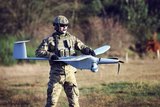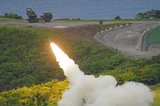Northrop Grumman awarded $517 million agreement for US Army Airship with unblinking eye
A new hybrid airship weapons system, just larger than the length of a football field, will take to the skies in just 18 months to provide an unblinking, persistent eye for more than three weeks at a time to aid US Army troops in Afghanistan, according to Northrop Grumman Corporation officials.
The company today announced it has been awarded a $517 million (£350.6 million) agreement to develop up to three Long Endurance Multi-Intelligence Vehicle (LEMV) systems for the US Army. Northrop Grumman has designed a system with plug-and-play capability to readily integrate into the Army's existing common ground station command centers and ground troops in forward operating bases-the main objective to provide US warfighters with persistent ISR capability to increase awareness of the ever changing battlefield.
"This opportunity leverages our longstanding leadership positions in developing innovative unmanned air vehicles, C4ISR weapon systems, and leading edge systems integration, and moves Northrop Grumman into this rapidly emerging market space of airships for the military and homeland defense arenas," said Gary Ervin, corporate vice president and president of Northrop Grumman Aerospace Systems sector.
Under the agreement, awarded by the US Army Space and Missile Defense Command/Army Forces Strategic Command, Northrop Grumman will design, develop and test a long-duration hybrid airship system within an 18-month time period, and then transport the asset to the Middle East for military assessment.
"It is critical that our warfighters are equipped with more enabling integrated ISR capability to tackle today's and tomorrow's conflicts," said Alan Metzger, Northrop Grumman LEMV program manager. "Our offering supports the Army's Joint Military Utility Assessment that this disruptive innovation must meet the Army's objective of a persistent unblinking stare while providing increased operational utility to battlefield commanders. Part of our innovative offering includes open architecture design in the payload bay to allow sensor changes by service personnel in the field."
LEMV will sustain altitudes of 20,000 feet for a three-week period, and it will operate within national and international airspace. It will be forward-located to support extended geostationary operations from austere operating locations using beyond-line-of-sight command and control.
Northrop Grumman has teamed with Hybrid Air Vehicles, Ltd. of the United Kingdom using its HAV304 platform, Warwick Mills, ILC Dover, AAI Corporation, SAIC, and a team of technology leaders from 18 US states to build LEMV. Northrop Grumman will provide system integration expertise and flight and ground control operations to safely take off and land the unmanned vehicle for worldwide operations.
Source: Northrop Grumman
More from Digital Battlespace
-
![Babcock nears first customer for Nomad AI translation tool]()
Babcock nears first customer for Nomad AI translation tool
Nomad can provide militaries with real-time intelligence, saving critical time on the battlefield.
-
![AUSA 2025: Israel’s Asio Technologies to supply hundreds of improved Taurus tactical systems]()
AUSA 2025: Israel’s Asio Technologies to supply hundreds of improved Taurus tactical systems
Taurus operates alongside the Israel Defense Forces’ Orion system which supports mission management across tens of thousands of manoeuvring forces, from squad leaders to battalion commanders.
-
![AUSA 2025: Kopin pushes micro-LED plans as China moves faster]()
AUSA 2025: Kopin pushes micro-LED plans as China moves faster
The plan for the new displays follows fresh investment in Kopin’s European facilities by Theon and an order for head-up displays in fielded aircraft, with funding from the US Department of Defense.
-
![AUSA 2025: Persistent Systems to complete its largest order by year’s end]()
AUSA 2025: Persistent Systems to complete its largest order by year’s end
Persistent Systems received its largest ever single order for its MPU5 devices and other systems earlier this month and has already delivered the 50 units to the US Army’s 4th Infantry Division.
-
![Aselsan brings in dozens of companies and systems under the Steel Dome umbrella]()
Aselsan brings in dozens of companies and systems under the Steel Dome umbrella
Turkey has joined the family of countries attempting to establish a multilayered air defence system with government approval in August 2024 for the effort landed by Aselsan. Dubbed Steel Dome, the programme joins Israel’s Iron Dome, the US Golden Dome, India’s Mission Sudarshan Chakra and South Korea’s low-altitude missile defence system.
-
![DSEI 2025: MARSS unveils new agnostic multidomain C4 system]()
DSEI 2025: MARSS unveils new agnostic multidomain C4 system
MARSS’ NiDAR system has been deployed using sensors from static platforms to provide detection and protection for static sights, such as critical infrastructure, ports and military bases.




























